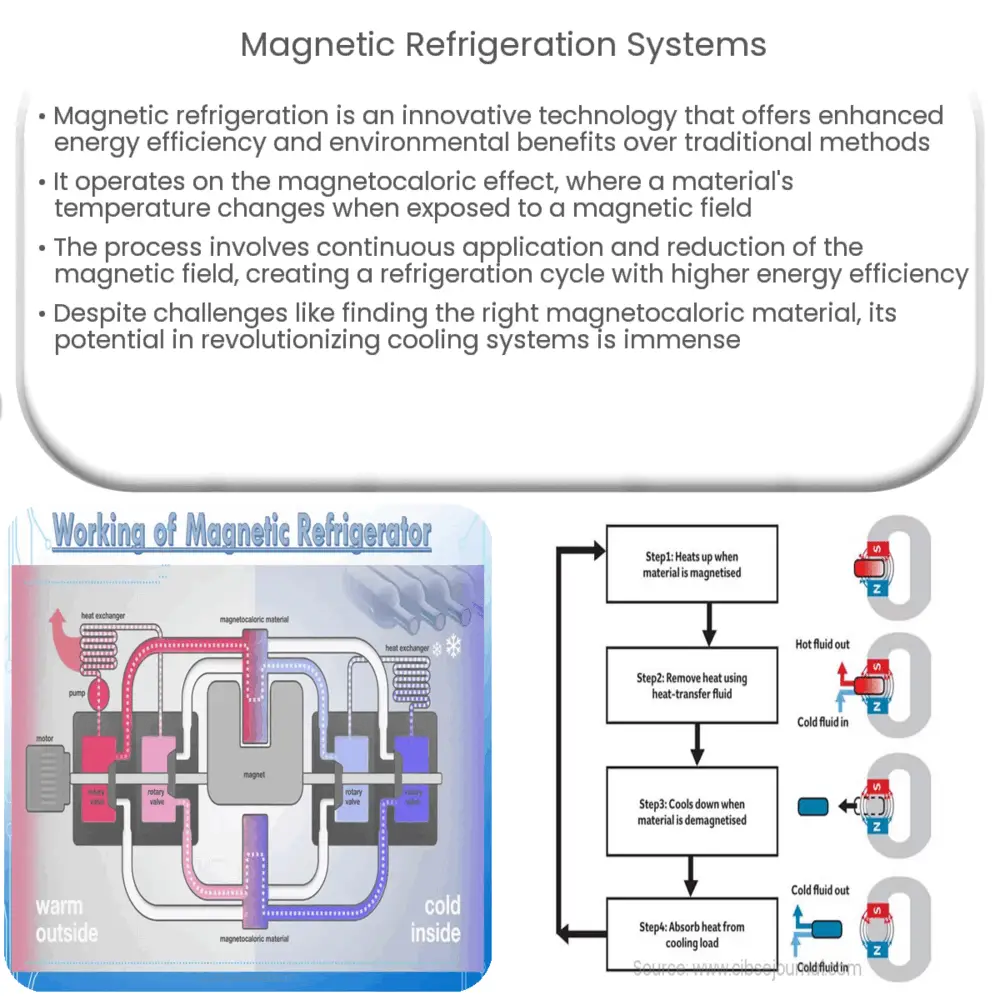Explore the future of cooling systems with magnetic refrigeration, a sustainable technology harnessing the magnetocaloric effect.

Magnetic Refrigeration: A Peek into the Future of Cooling Systems
Magnetic refrigeration represents a cutting-edge technology with the potential to revolutionize our cooling systems. Based on the concept of magnetocaloric effect (MCE), this innovative technique offers superior energy efficiency and environmental friendliness compared to conventional refrigeration methods.
Understanding the Magnetocaloric Effect
The underlying principle of magnetic refrigeration, the magnetocaloric effect, is a phenomenon in which a material’s temperature changes when it is exposed to a magnetic field. This effect was first observed in the early 20th century but has gained considerable attention in recent years due to its promising applications in refrigeration systems.
The Mechanics of Magnetic Refrigeration
A magnetic refrigerator operates by using a magnetocaloric material—typically a type of alloy—placed within a magnetic field. When the magnetic field is applied, the orientation of the material’s magnetic moments aligns, leading to an increase in the material’s temperature, a process known as adiabatic magnetization. The system then uses a fluid, such as water, to remove the heat generated.
- Adiabatic Demagnetization: After removing the heat, the magnetic field is reduced, causing the magnetic moments to become disordered again. This results in a decrease in the material’s temperature below its initial value, a phenomenon called adiabatic demagnetization. The cold material can then absorb heat from the surroundings, thus providing the cooling effect.
- Refrigeration Cycle: By continuously repeating this process of applying and reducing the magnetic field, a magnetic refrigeration system creates a refrigeration cycle. This cycle provides continuous cooling, just like in conventional refrigeration systems, but with the added benefits of higher energy efficiency and less environmental impact.
Advantages of Magnetic Refrigeration
Magnetic refrigeration boasts several significant advantages over traditional refrigeration methods. Firstly, magnetic refrigeration is remarkably energy-efficient. It uses less electricity than standard methods, as it relies on the magnetocaloric effect instead of gas compression and expansion. Secondly, it’s environmentally friendly—unlike conventional refrigeration, it doesn’t use harmful chlorofluorocarbons (CFCs) or hydrochlorofluorocarbons (HCFCs), which contribute to ozone layer depletion and global warming.
In the next part of this article, we’ll delve deeper into the applications and challenges of magnetic refrigeration, as well as the strides researchers are making to bring this exciting technology to market.
Applications of Magnetic Refrigeration
The potential applications of magnetic refrigeration are far-reaching and varied. While it has yet to become commonplace, there are already examples of its use in the field of low-temperature physics, where it’s employed to reach near absolute zero temperatures. Additionally, it’s being explored for domestic refrigeration and air conditioning systems, providing an energy-efficient, eco-friendly alternative to existing technologies. The commercial sector is also an attractive prospective domain, with potential uses in grocery stores, warehouses, and other areas requiring large-scale cooling solutions.
Challenges and Future Prospects
Despite the numerous advantages of magnetic refrigeration, a few challenges need to be addressed before it becomes widely adopted. Firstly, finding the right magnetocaloric material—one that’s both effective and affordable—is crucial. Secondly, the technology requires strong magnetic fields, which can be expensive and challenging to maintain.
However, researchers are working hard to overcome these obstacles. There are ongoing studies to discover new magnetocaloric materials that work at different temperature ranges, including room temperature. Additionally, efforts are being made to optimize the design of magnetic refrigeration systems, to make them more practical and cost-effective.
Conclusion
Magnetic refrigeration presents a compelling vision for the future of cooling systems. With its inherent energy efficiency and environmental benefits, it has the potential to replace conventional refrigeration techniques. Although challenges remain in bringing this technology to widespread use, the ongoing research and development efforts are encouraging. As we become more conscious of our energy use and environmental impact, technologies like magnetic refrigeration will undoubtedly become increasingly significant.
In the face of global warming and the pressing need to conserve energy, it’s safe to say that magnetic refrigeration isn’t just an interesting concept—it could be an essential piece of our sustainable future.

